Apache ShenYu 是一个异步的,高性能的,跨语言的,响应式的 API 网关。
在ShenYu网关中,注册中心是用于将客户端信息注册到shenyu-admin,admin再通过数据同步将这些信息同步到网关,网关通过这些数据完成流量筛选。客户端信息主要包括接口信息和URI信息。
本文基于shenyu-2.4.1版本进行源码分析,官网的介绍请参考 客户端接入原理 。
1. 注册中心原理
当客户端启动时,读取接口信息和uri信息,通过指定的注册类型,将数据发送到shenyu-admin。
图中的注册中心需要用户指定使用哪种注册类型,ShenYu当前支持Http、Zookeeper、Etcd、Consul和Nacos进行注册。具体如何配置请参考 客户端接入配置 。
ShenYu在注册中心的原理设计上引入了Disruptor,Disruptor队列在其中起到数据与操作解耦,利于扩展。如果注册请求过多,导致注册异常,也有数据缓冲作用。
如图所示,注册中心分为两个部分,一是注册中心客户端register-client,负载处理客户端数据读取。另一个是注册中心服务端register-server,负载处理服务端(就是shenyu-admin)数据写入。通过指定注册类型进行数据发送和接收。
客户端:通常来说就是一个微服务,可以是springmvc,spring-cloud,dubbo,grpc等。
register-client:注册中心客户端,读取客户接口和uri信息。
Disruptor:数据与操作解耦,数据缓冲作用。
register-server:注册中心服务端,这里就是shenyu-admin,接收数据,写入数据库,发数据同步事件。
注册类型:指定注册类型,完成数据注册,当前支持Http、Zookeeper、Etcd、Consul和Nacos。
本文分析的是使用Http的方式进行注册,所以具体的处理流程如下:
在客户端,数据出队列后,通过http传输数据,在服务端,提供相应的接口,接收数据,然后写入队列。
2. 客户端注册流程
当客户端启动后,根据相关配置,读取属性信息,然后写入队列。以官方提供的 shenyu-examples-http 为例,开始源码分析。官方提供的例子是一个由springboot构建的微服务。注册中心的相关配置可以参考官网 客户端接入配置 。
2.1 加载配置,读取属性
先用一张图串联下注册中心客户端初始化流程:
我们分析的是通过http的方式进行注册,所以需要进行如下配置:
shenyu: register: registerType: http serverLists: http://localhost:9095 client: http: props: contextPath: /http appName: http port: 8189 isFull: false
复制代码
每个属性表示的含义如下:
registerType : 服务注册类型,填写 http。
serverList: 为http注册类型时,填写Shenyu-Admin项目的地址,注意加上http://,多个地址用英文逗号分隔。
port: 你本项目的启动端口,目前springmvc/tars/grpc需要进行填写。
contextPath: 为你的这个mvc项目在shenyu网关的路由前缀, 比如/order ,/product 等等,网关会根据你的这个前缀来进行路由。
appName:你的应用名称,不配置的话,会默认取 spring.application.name 的值。
isFull: 设置 true 代表代理你的整个服务,false表示代理你其中某几个controller;目前适用于springmvc/springcloud。
项目启动后,会先加载配置文件,读取属性信息,生成相应的Bean。
首先读取到的配置文件是 ShenyuSpringMvcClientConfiguration,它是shenyu 客户端http注册配置类,通过@Configuration表示这是一个配置类,通过@ImportAutoConfiguration引入其他配置类。创建SpringMvcClientBeanPostProcessor,主要处理元数据。创建ContextRegisterListener,主要处理 URI 信息。
/** * shenyu 客户端http注册配置类 */@Configuration@ImportAutoConfiguration(ShenyuClientCommonBeanConfiguration.class)public class ShenyuSpringMvcClientConfiguration {
//创建SpringMvcClientBeanPostProcessor,主要处理元数据 @Bean public SpringMvcClientBeanPostProcessor springHttpClientBeanPostProcessor(final ShenyuClientConfig clientConfig,final ShenyuClientRegisterRepository shenyuClientRegisterRepository) { return new SpringMvcClientBeanPostProcessor(clientConfig.getClient().get(RpcTypeEnum.HTTP.getName()), shenyuClientRegisterRepository); } // 创建ContextRegisterListener,主要处理 URI信息 @Bean public ContextRegisterListener contextRegisterListener(final ShenyuClientConfig clientConfig) { return new ContextRegisterListener(clientConfig.getClient().get(RpcTypeEnum.HTTP.getName())); }}
复制代码
ShenyuClientCommonBeanConfiguration是shenyu客户端通用配置类,会创建注册中心客户端通用的bean。
创建ShenyuClientRegisterRepository,通过工厂类创建而成。
创建ShenyuRegisterCenterConfig,读取shenyu.register属性配置。
创建ShenyuClientConfig,读取shenyu.client属性配置。
/** * shenyu客户端通用配置类 */@Configurationpublic class ShenyuClientCommonBeanConfiguration { // 创建ShenyuClientRegisterRepository,通过工厂类创建而成。 @Bean public ShenyuClientRegisterRepository shenyuClientRegisterRepository(final ShenyuRegisterCenterConfig config) { return ShenyuClientRegisterRepositoryFactory.newInstance(config); } // 创建ShenyuRegisterCenterConfig,读取shenyu.register属性配置 @Bean @ConfigurationProperties(prefix = "shenyu.register") public ShenyuRegisterCenterConfig shenyuRegisterCenterConfig() { return new ShenyuRegisterCenterConfig(); } // 创建ShenyuClientConfig,读取shenyu.client属性配置 @Bean @ConfigurationProperties(prefix = "shenyu") public ShenyuClientConfig shenyuClientConfig() { return new ShenyuClientConfig(); }}
复制代码
2.2 用于注册的 HttpClientRegisterRepository
上面的配置文件中生成的ShenyuClientRegisterRepository是客户端注册的具体实现,它是一个接口,它的实现类如下。
HttpClientRegisterRepository:通过http进行注册;
ConsulClientRegisterRepository:通过Consul进行注册;
EtcdClientRegisterRepository:通过Etcd进行注册;
NacosClientRegisterRepository:通过nacos进行注册;
ZookeeperClientRegisterRepository通过Zookeeper进行注册。
具体是哪一种方式,是通过SPI进行加载实现的,实现逻辑如下:
/** * 加载 ShenyuClientRegisterRepository */public final class ShenyuClientRegisterRepositoryFactory { private static final Map<String, ShenyuClientRegisterRepository> REPOSITORY_MAP = new ConcurrentHashMap<>(); /** * 创建 ShenyuClientRegisterRepository */ public static ShenyuClientRegisterRepository newInstance(final ShenyuRegisterCenterConfig shenyuRegisterCenterConfig) { if (!REPOSITORY_MAP.containsKey(shenyuRegisterCenterConfig.getRegisterType())) { // 通过SPI的方式进行加载,类型由registerType决定 ShenyuClientRegisterRepository result = ExtensionLoader.getExtensionLoader(ShenyuClientRegisterRepository.class).getJoin(shenyuRegisterCenterConfig.getRegisterType()); //执行初始化操作 result.init(shenyuRegisterCenterConfig); ShenyuClientShutdownHook.set(result, shenyuRegisterCenterConfig.getProps()); REPOSITORY_MAP.put(shenyuRegisterCenterConfig.getRegisterType(), result); return result; } return REPOSITORY_MAP.get(shenyuRegisterCenterConfig.getRegisterType()); }}
复制代码
加载类型通过registerType指定,也就是我们在配置文件中指定的类型:
shenyu: register: registerType: http serverLists: http://localhost:9095
复制代码
我们指定的是http,所以会去加载HttpClientRegisterRepository。对象创建成功后,执行的初始化方法init()如下:
@Joinpublic class HttpClientRegisterRepository implements ShenyuClientRegisterRepository { @Override public void init(final ShenyuRegisterCenterConfig config) { this.serverList = Lists.newArrayList(Splitter.on(",").split(config.getServerLists())); } // 暂时省略其他逻辑}
复制代码
读取配置文件中的serverLists,即sheenyu-admin的地址,为后续数据发送做准备。类注解@Join用于SPI的加载。
SPI 全称为 Service Provider Interface, 是 JDK 内置的一种服务提供发现功能, 一种动态替换发现的机制。
shenyu-spi 是Apache ShenYu网关自定义的SPI扩展实现,设计和实现原理参考了Dubbo的 SPI扩展实现 。
2.3 构建元数据的 SpringMvcClientBeanPostProcessor
创建SpringMvcClientBeanPostProcessor,负责元数据的构建和注册,它的构造函数逻辑如下:
/** * spring mvc 客户端bean的后置处理器 */public class SpringMvcClientBeanPostProcessor implements BeanPostProcessor {
/** * 通过构造函数进行实例化 */ public SpringMvcClientBeanPostProcessor(final PropertiesConfig clientConfig, final ShenyuClientRegisterRepository shenyuClientRegisterRepository) { // 读取配置属性 Properties props = clientConfig.getProps(); // 获取端口信息,并校验 int port = Integer.parseInt(props.getProperty(ShenyuClientConstants.PORT)); if (port <= 0) { String errorMsg = "http register param must config the port must > 0"; LOG.error(errorMsg); throw new ShenyuClientIllegalArgumentException(errorMsg); } // 获取appName this.appName = props.getProperty(ShenyuClientConstants.APP_NAME); // 获取contextPath this.contextPath = props.getProperty(ShenyuClientConstants.CONTEXT_PATH); // 校验appName和contextPath if (StringUtils.isBlank(appName) && StringUtils.isBlank(contextPath)) { String errorMsg = "http register param must config the appName or contextPath"; LOG.error(errorMsg); throw new ShenyuClientIllegalArgumentException(errorMsg); } // 获取 isFull this.isFull = Boolean.parseBoolean(props.getProperty(ShenyuClientConstants.IS_FULL, Boolean.FALSE.toString())); // 开始事件发布 publisher.start(shenyuClientRegisterRepository); }
// 暂时省略了其他逻辑 @Override public Object postProcessAfterInitialization(@NonNull final Object bean, @NonNull final String beanName) throws BeansException { // 暂时省略了其他逻辑 }
}
复制代码
在构造函数中,主要是读取属性信息,然后进行校验。
shenyu: client: http: props: contextPath: /http appName: http port: 8189 isFull: false
复制代码
最后,执行了 publisher.start(),开始事件发布,为注册做准备。
ShenyuClientRegisterEventPublisher通过单例模式实现,主要是生成元数据和URI订阅器(后续用于数据发布),然后启动Disruptor队列。提供了一个共有方法publishEvent(),发布事件,向 Disruptor 队列发数据。
public class ShenyuClientRegisterEventPublisher { // 私有变量 private static final ShenyuClientRegisterEventPublisher INSTANCE = new ShenyuClientRegisterEventPublisher(); private DisruptorProviderManage providerManage; private RegisterClientExecutorFactory factory; /** * 公开静态方法 * * @return ShenyuClientRegisterEventPublisher instance */ public static ShenyuClientRegisterEventPublisher getInstance() { return INSTANCE; } /** * Start方法执行 * * @param shenyuClientRegisterRepository shenyuClientRegisterRepository */ public void start(final ShenyuClientRegisterRepository shenyuClientRegisterRepository) { // 创建客户端注册工厂类 factory = new RegisterClientExecutorFactory(); // 添加元数据订阅器 factory.addSubscribers(new ShenyuClientMetadataExecutorSubscriber(shenyuClientRegisterRepository)); // 添加URI订阅器 factory.addSubscribers(new ShenyuClientURIExecutorSubscriber(shenyuClientRegisterRepository)); // 启动Disruptor队列 providerManage = new DisruptorProviderManage(factory); providerManage.startup(); } /** * 发布事件,向Disruptor队列发数据 * * @param <T> the type parameter * @param data the data */ public <T> void publishEvent(final T data) { DisruptorProvider<Object> provider = providerManage.getProvider(); provider.onData(f -> f.setData(data)); }}
复制代码
SpringMvcClientBeanPostProcessor的构造函数逻辑分析完了,主要是读取属性配置,创建元数据和URI订阅器, 启动Disruptor队列。要注意到它实现了BeanPostProcessor,这是Spring提供的一个接口,在Bean的生命周期中,真正开始使用之前,会执行后置处理器的postProcessAfterInitialization()方法。
SpringMvcClientBeanPostProcessor作为一个后置处理器,它的功能是:读取注解中的元数据,并向admin注册。
// 后置处理器public class SpringMvcClientBeanPostProcessor implements BeanPostProcessor { // 省略了其他逻辑 // 后置处理器:读取注解中的元数据,并向admin注册 @Override public Object postProcessAfterInitialization(@NonNull final Object bean, @NonNull final String beanName) throws BeansException { // 配置属性,如果 isFull=true 的话,表示注册整个微服务 if (isFull) { return bean; } // 获取当前bean的Controller注解 Controller controller = AnnotationUtils.findAnnotation(bean.getClass(), Controller.class); // 获取当前bean的RequestMapping注解 RequestMapping requestMapping = AnnotationUtils.findAnnotation(bean.getClass(), RequestMapping.class); // 如果这个bean是一个接口 if (controller != null || requestMapping != null) { // 获取当前bean的 ShenyuSpringMvcClient 注解 ShenyuSpringMvcClient clazzAnnotation = AnnotationUtils.findAnnotation(bean.getClass(), ShenyuSpringMvcClient.class); String prePath = ""; //如果没有 ShenyuSpringMvcClient 注解,就返回,表示这个接口不需要注册 if (Objects.isNull(clazzAnnotation)) { return bean; } //如果 ShenyuSpringMvcClient 注解中的path属性包括 * ,表示注册整个接口 if (clazzAnnotation.path().indexOf("*") > 1) { // 构建元数据,发送注册事件 publisher.publishEvent(buildMetaDataDTO(clazzAnnotation, prePath)); return bean; } prePath = clazzAnnotation.path(); // 获取当前bean的所有方法 final Method[] methods = ReflectionUtils.getUniqueDeclaredMethods(bean.getClass()); // 遍历方法 for (Method method : methods) { // 获取当前方法上的注解 ShenyuSpringMvcClient ShenyuSpringMvcClient shenyuSpringMvcClient = AnnotationUtils.findAnnotation(method, ShenyuSpringMvcClient.class); // 如果方法上有注解ShenyuSpringMvcClient,就表示该方法需要注册 if (Objects.nonNull(shenyuSpringMvcClient)) { // 构建元数据,发送注册事件 publisher.publishEvent(buildMetaDataDTO(shenyuSpringMvcClient, prePath)); } } } return bean; }
// 构造元数据 private MetaDataRegisterDTO buildMetaDataDTO(final ShenyuSpringMvcClient shenyuSpringMvcClient, final String prePath) { // contextPath上下文名称 String contextPath = this.contextPath; // appName应用名称 String appName = this.appName; // path注册路径 String path; if (StringUtils.isEmpty(contextPath)) { path = prePath + shenyuSpringMvcClient.path(); } else { path = contextPath + prePath + shenyuSpringMvcClient.path(); } // desc描述信息 String desc = shenyuSpringMvcClient.desc(); // ruleName规则名称,没有填写的话就和path一致 String configRuleName = shenyuSpringMvcClient.ruleName(); String ruleName = StringUtils.isBlank(configRuleName) ? path : configRuleName; // 构建元数据 return MetaDataRegisterDTO.builder() .contextPath(contextPath) .appName(appName) .path(path) .pathDesc(desc) .rpcType(RpcTypeEnum.HTTP.getName()) .enabled(shenyuSpringMvcClient.enabled()) .ruleName(ruleName) .registerMetaData(shenyuSpringMvcClient.registerMetaData()) .build(); }}
复制代码
在后置处理器中,需要读取配置属性,如果 isFull=true 的话,表示注册整个微服务。获取当前bean的Controller注解、RequestMapping注解、ShenyuSpringMvcClient 注解,通过读取这些注解信息判断当前bean是否是接口?接口是否需要注册?方法是否需要注册?然后根据ShenyuSpringMvcClient 注解中的属性构建元数据,最后通过publisher.publishEvent()发布事件进行注册。
Controller注解和RequestMapping注解是由Spring提供的,这个大家应该很熟悉,不过多赘述。ShenyuSpringMvcClient 注解是由Apache ShenYu提供的,用于注册SpringMvc客户端,它的定义如下:
/** * shenyu 客户端接口,用于方法上或类上 */@Retention(RetentionPolicy.RUNTIME)@Target({ElementType.TYPE, ElementType.METHOD})public @interface ShenyuSpringMvcClient { // path 注册路径 String path(); // ruleName 规则名称 String ruleName() default ""; // desc 描述信息 String desc() default "";
// enabled是否启用 boolean enabled() default true; // registerMetaData 注册元数据 boolean registerMetaData() default false;}
复制代码
它的使用如下:
@RestController@RequestMapping("/test")@ShenyuSpringMvcClient(path = "/test/**") // 表示整个接口注册public class HttpTestController { //......}
复制代码
@RestController@RequestMapping("/order")@ShenyuSpringMvcClient(path = "/order")public class OrderController {
/** * Save order dto. * * @param orderDTO the order dto * @return the order dto */ @PostMapping("/save") @ShenyuSpringMvcClient(path = "/save", desc = "Save order") // 注册当前方法 public OrderDTO save(@RequestBody final OrderDTO orderDTO) { orderDTO.setName("hello world save order"); return orderDTO; }
复制代码
该方法会将数据发送到Disruptor队列中,关于Disruptor队列更多细节这里不做更多介绍,这不影响分析注册的流程。
当数据发送后,Disruptor队列的消费者会处理数据,进行消费。
QueueConsumer是一个消费者,它实现了WorkHandler接口,它的创建过程在providerManage.startup()逻辑中。WorkHandler接口是disruptor的数据消费接口,只有一个方法是onEvent()。
package com.lmax.disruptor;
public interface WorkHandler<T> { void onEvent(T var1) throws Exception;}
复制代码
QueueConsumer重写了onEvent()方法,主要逻辑是生成消费任务,然后在线程池中去执行。
/** * * 队列消费者 */public class QueueConsumer<T> implements WorkHandler<DataEvent<T>> { // 省略了其他逻辑
@Override public void onEvent(final DataEvent<T> t) { if (t != null) { // 通过工厂创建队列消费任务 QueueConsumerExecutor<T> queueConsumerExecutor = factory.create(); // 保存数据 queueConsumerExecutor.setData(t.getData()); // help gc t.setData(null); // 放在线程池中执行 消费任务 executor.execute(queueConsumerExecutor); } }}
复制代码
QueueConsumerExecutor是在线程池中被执行的任务,它实现了Runnable接口,具体的实现类有两个:
顾名思义,一个负责处理客户端任务,一个负责处理服务端任务(服务端就是admin,在下文进行分析)。
重写的run()逻辑如下:
public final class RegisterClientConsumerExecutor extends QueueConsumerExecutor<DataTypeParent> { //......
@Override public void run() { // 获取数据 DataTypeParent dataTypeParent = getData(); // 根据数据类型调用相应的处理器进行处理 subscribers.get(dataTypeParent.getType()).executor(Lists.newArrayList(dataTypeParent)); } }
复制代码
根据不同的数据类型调用不同的处理器去执行相应的任务。数据类型有两种,一个是元数据,记录客户端注册信息。一个是URI数据,记录客户端服务信息。
//数据类型public enum DataType { // 元数据 META_DATA, // URI数据 URI,}
复制代码
执行器订阅者也分为两类,一个是处理元数据,一个是处理URI。在客户端和服务端分别有两个,所以一共是四个。
客户端这边对元数据处理逻辑是:遍历元数据信息,调用接口方法persistInterface()完成数据的发布。
public class ShenyuClientMetadataExecutorSubscriber implements ExecutorTypeSubscriber<MetaDataRegisterDTO> { //...... @Override public DataType getType() { return DataType.META_DATA; // 元数据 } @Override public void executor(final Collection<MetaDataRegisterDTO> metaDataRegisterDTOList) { for (MetaDataRegisterDTO metaDataRegisterDTO : metaDataRegisterDTOList) { // 调用接口方法persistInterface()完成数据的发布 shenyuClientRegisterRepository.persistInterface(metaDataRegisterDTO); } }}
复制代码
ShenyuClientRegisterRepository是一个接口,用于表示客户端数据注册,它的实现类目前有五种,每一种就表示一种注册方法。
ConsulClientRegisterRepository:通过Consul实现客户端注册;
EtcdClientRegisterRepository:通过Etcd实现客户端注册;
HttpClientRegisterRepository:通过Http实现客户端注册;
NacosClientRegisterRepository:通过Nacos实现客户端注册;
ZookeeperClientRegisterRepository:通过Zookeeper实现客户端注册;
从图中可以看出,注册中心的加载是通过SPI的方式完成的。这个在前面提到过了,在客户端通用配置文件中,通过指定配置文件中的属性完成具体的类加载。
/** * 加载 ShenyuClientRegisterRepository */public final class ShenyuClientRegisterRepositoryFactory { private static final Map<String, ShenyuClientRegisterRepository> REPOSITORY_MAP = new ConcurrentHashMap<>(); /** * 创建 ShenyuClientRegisterRepository */ public static ShenyuClientRegisterRepository newInstance(final ShenyuRegisterCenterConfig shenyuRegisterCenterConfig) { if (!REPOSITORY_MAP.containsKey(shenyuRegisterCenterConfig.getRegisterType())) { // 通过SPI的方式进行加载,类型由registerType决定 ShenyuClientRegisterRepository result = ExtensionLoader.getExtensionLoader(ShenyuClientRegisterRepository.class).getJoin(shenyuRegisterCenterConfig.getRegisterType()); //执行初始化操作 result.init(shenyuRegisterCenterConfig); ShenyuClientShutdownHook.set(result, shenyuRegisterCenterConfig.getProps()); REPOSITORY_MAP.put(shenyuRegisterCenterConfig.getRegisterType(), result); return result; } return REPOSITORY_MAP.get(shenyuRegisterCenterConfig.getRegisterType()); }}
复制代码
本文的源码分析是基于Http的方式进行注册,所以我们先分析HttpClientRegisterRepository,其他的注册方式后续再分析。
通过http的方式注册很简单,就是调用工具类发送http请求。注册元数据和 URI 都是调用的同一个方法doRegister(),指定接口和类型就好。
@Joinpublic class HttpClientRegisterRepository implements ShenyuClientRegisterRepository { // 服务端提供的接口用于注册元数据 private static final String META_PATH = "/shenyu-client/register-metadata";
// 服务端提供的接口用于注册URI private static final String URI_PATH = "/shenyu-client/register-uri";
//注册URI @Override public void persistURI(final URIRegisterDTO registerDTO) { doRegister(registerDTO, URI_PATH, Constants.URI); } //注册接口(就是元数据信息) @Override public void persistInterface(final MetaDataRegisterDTO metadata) { doRegister(metadata, META_PATH, META_TYPE); } // 进行注册 private <T> void doRegister(final T t, final String path, final String type) { // 遍历admin服务列表(admin可能是集群) for (String server : serverList) { try { // 调用工具类发送 http 请求 RegisterUtils.doRegister(GsonUtils.getInstance().toJson(t), server + path, type); return; } catch (Exception e) { LOGGER.error("register admin url :{} is fail, will retry", server); } } }}
复制代码
将数据序列化后,通过OkHttp发送数据。
public final class RegisterUtils { //......
// 通过OkHttp发送数据 public static void doRegister(final String json, final String url, final String type) throws IOException { String result = OkHttpTools.getInstance().post(url, json); if (Objects.equals(SUCCESS, result)) { LOGGER.info("{} client register success: {} ", type, json); } else { LOGGER.error("{} client register error: {} ", type, json); } }}
复制代码
至此,客户端通过http的方式注册元数据的逻辑就分析完了。小结一下:通过读取自定义的注解信息构造元数据,将数据发到Disruptor队列,然后从队列中消费数据,将消费者放到线程池中去执行,最终通过发送http请求到admin。
客户端元数据注册流程的源码分析过程完成了,用流程图描述如下:
2.4 构建 URI 的 ContextRegisterListener
创建 ContextRegisterListener,负责客户端URI数据的构建和注册,它的创建是在配置文件中完成。
@Configuration@ImportAutoConfiguration(ShenyuClientCommonBeanConfiguration.class)public class ShenyuSpringMvcClientConfiguration { // ...... // 创建 ContextRegisterListener @Bean public ContextRegisterListener contextRegisterListener(final ShenyuClientConfig clientConfig) { return new ContextRegisterListener(clientConfig.getClient().get(RpcTypeEnum.HTTP.getName())); }}
复制代码
ContextRegisterListener实现了ApplicationListener接口,并重写了onApplicationEvent()方法,当有 Spring 事件发生后,该方法会执行。
// 实现了ApplicationListener接口public class ContextRegisterListener implements ApplicationListener<ContextRefreshedEvent> {
//......
//通过构造函数完成实例化 public ContextRegisterListener(final PropertiesConfig clientConfig) { // 读取 shenyu.client.http 配置信息 Properties props = clientConfig.getProps(); // isFull是否注册整个服务 this.isFull = Boolean.parseBoolean(props.getProperty(ShenyuClientConstants.IS_FULL, Boolean.FALSE.toString())); // contextPath上下文路径 String contextPath = props.getProperty(ShenyuClientConstants.CONTEXT_PATH); this.contextPath = contextPath; if (isFull) { if (StringUtils.isBlank(contextPath)) { String errorMsg = "http register param must config the contextPath"; LOG.error(errorMsg); throw new ShenyuClientIllegalArgumentException(errorMsg); } this.contextPath = contextPath + "/**"; } // port 客户端端口信息 int port = Integer.parseInt(props.getProperty(ShenyuClientConstants.PORT)); // appName 应用名称 this.appName = props.getProperty(ShenyuClientConstants.APP_NAME); // host信息 this.host = props.getProperty(ShenyuClientConstants.HOST); this.port = port; }
// 当有上下文刷新事件ContextRefreshedEvent发生时,该方法会执行 @Override public void onApplicationEvent(@NonNull final ContextRefreshedEvent contextRefreshedEvent) { //保证该方法的内容只执行一次 if (!registered.compareAndSet(false, true)) { return; } // 如果是 isFull=true 代表注册整个服务,构建元数据并注册 if (isFull) { publisher.publishEvent(buildMetaDataDTO()); } // 构建URI数据并注册 publisher.publishEvent(buildURIRegisterDTO()); }
// 构建URI数据 private URIRegisterDTO buildURIRegisterDTO() { String host = IpUtils.isCompleteHost(this.host) ? this.host : IpUtils.getHost(this.host); return URIRegisterDTO.builder() .contextPath(this.contextPath) .appName(appName) .host(host) .port(port) .rpcType(RpcTypeEnum.HTTP.getName()) .build(); }
// 构建元数据 private MetaDataRegisterDTO buildMetaDataDTO() { String contextPath = this.contextPath; String appName = this.appName; return MetaDataRegisterDTO.builder() .contextPath(contextPath) .appName(appName) .path(contextPath) .rpcType(RpcTypeEnum.HTTP.getName()) .enabled(true) .ruleName(contextPath) .build(); }}
复制代码
在构造函数中主要是读取属性配置。
onApplicationEvent()方法是有Spring事件发生时会执行,这里的参数是ContextRefreshedEvent,表示上下文刷新事件。当Spring容器就绪后执行此处逻辑:如果是 isFull=true 代表注册整个服务,构建元数据并注册,在前面分析的后置处理器SpringMvcClientBeanPostProcessor中没有处理 isFull=true 的情况,所以在此处进行了处理。然后再构建URI数据并注册。
ContextRefreshedEvent是Spring内置事件。ApplicationContext被初始化或刷新时,该事件被触发。这也可以在 ConfigurableApplicationContext接口中使用 refresh() 方法来发生。此处的初始化是指:所有的Bean被成功装载,后处理Bean被检测并激活,所有Singleton Bean 被预实例化,ApplicationContext容器已就绪可用。
注册逻辑都是通过 publisher.publishEvent()完成。在前面都已经分析过了:向Disruptor队列写入数据,再从中消费数据,最后通过ExecutorSubscriber去处理。
执行器订阅者分为两类,一个是处理元数据,一个是处理URI。在客户端和服务端分别有两个,所以一共是四个。
这里是注册URI信息,所以执行类是ShenyuClientURIExecutorSubscriber。
主要逻辑是遍历 URI 数据集合,通过persistURI()方法实现数据注册。
public class ShenyuClientURIExecutorSubscriber implements ExecutorTypeSubscriber<URIRegisterDTO> { //...... @Override public DataType getType() { return DataType.URI; //数据类型是URI } // 注册URI数据 @Override public void executor(final Collection<URIRegisterDTO> dataList) { for (URIRegisterDTO uriRegisterDTO : dataList) { Stopwatch stopwatch = Stopwatch.createStarted(); while (true) { try (Socket ignored = new Socket(uriRegisterDTO.getHost(), uriRegisterDTO.getPort())) { break; } catch (IOException e) { long sleepTime = 1000; // maybe the port is delay exposed if (stopwatch.elapsed(TimeUnit.SECONDS) > 5) { LOG.error("host:{}, port:{} connection failed, will retry", uriRegisterDTO.getHost(), uriRegisterDTO.getPort()); // If the connection fails for a long time, Increase sleep time if (stopwatch.elapsed(TimeUnit.SECONDS) > 180) { sleepTime = 10000; } } try { TimeUnit.MILLISECONDS.sleep(sleepTime); } catch (InterruptedException ex) { ex.printStackTrace(); } } } //添加hook,优雅停止客户端 ShenyuClientShutdownHook.delayOtherHooks(); // 注册URI shenyuClientRegisterRepository.persistURI(uriRegisterDTO); } }}
复制代码
代码中的while(true)循环是为了保证客户端已经成功启动了,通过host和port可以连接上。
后面的逻辑是:添加hook函数,用于优雅停止客户端 。
通过persistURI()方法实现数据注册。整个逻辑也在前面分析过了,最终就是通过OkHttp客户端向shenyu-admin发起http,通过http的方式注册URI。
分析到这里就将客户端的注册逻辑分析完了,将构建的元数据和 URI 数据发送到Disruptor队列,再从中消费,读取数据,通过http向admin发送数据。
客户端URI注册流程的源码分析完成了,流程图如下:
3. 服务端注册流程
3.1 注册接口 ShenyuHttpRegistryController
从前面的分析可以知道,服务端提供了注册的两个接口:
这两个接口位于ShenyuHttpRegistryController中,它实现了ShenyuServerRegisterRepository接口,是服务端注册的实现类。它用@Join标记,表示通过SPI进行加载。
// shenuyu客户端接口@RequestMapping("/shenyu-client")@Joinpublic class ShenyuHttpRegistryController implements ShenyuServerRegisterRepository {
private ShenyuServerRegisterPublisher publisher;
@Override public void init(final ShenyuServerRegisterPublisher publisher, final ShenyuRegisterCenterConfig config) { this.publisher = publisher; } // 注册元数据 @PostMapping("/register-metadata") @ResponseBody public String registerMetadata(@RequestBody final MetaDataRegisterDTO metaDataRegisterDTO) { publish(metaDataRegisterDTO); return ShenyuResultMessage.SUCCESS; } // 注册URI @PostMapping("/register-uri") @ResponseBody public String registerURI(@RequestBody final URIRegisterDTO uriRegisterDTO) { publish(uriRegisterDTO); return ShenyuResultMessage.SUCCESS; }
// 发布注册事件 private <T> void publish(final T t) { publisher.publish(Collections.singletonList(t)); }}
复制代码
两个注册接口获取到数据好,就调用了publish()方法,把数据发布到Disruptor队列中。
ShenyuServerRegisterRepository接口是服务注册接口,它有五个实现类,表示有五种注册方式:
ConsulServerRegisterRepository:通过Consul实现注册;
EtcdServerRegisterRepository:通过Etcd实现注册;
NacosServerRegisterRepository:通过Nacos实现注册;
ShenyuHttpRegistryController:通过Http实现注册;
ZookeeperServerRegisterRepository:通过Zookeeper实现注册。
具体用哪一种方式,是通过配置文件指定的,然后通过SPI进行加载。
在shenyu-admin中的application.yml文件中配置注册方式,registerType指定注册类型,当用http进行注册时,serverLists不需要填写,更多配置说明可以参考官网 客户端接入配置 。
shenyu: register: registerType: http serverLists:
复制代码
在引入相关依赖和属性配置后,启动shenyu-admin时,会先加载配置文件,和注册中心相关的配置文件类是RegisterCenterConfiguration。
// 注册中心配置类@Configurationpublic class RegisterCenterConfiguration { // 读取配置属性 @Bean @ConfigurationProperties(prefix = "shenyu.register") public ShenyuRegisterCenterConfig shenyuRegisterCenterConfig() { return new ShenyuRegisterCenterConfig(); } //创建ShenyuServerRegisterRepository,用于服务端注册 @Bean public ShenyuServerRegisterRepository shenyuServerRegisterRepository(final ShenyuRegisterCenterConfig shenyuRegisterCenterConfig, final List<ShenyuClientRegisterService> shenyuClientRegisterService) { // 1.从配置属性中获取注册类型 String registerType = shenyuRegisterCenterConfig.getRegisterType(); // 2.通过注册类型,以SPI的方法加载实现类 ShenyuServerRegisterRepository registerRepository = ExtensionLoader.getExtensionLoader(ShenyuServerRegisterRepository.class).getJoin(registerType); // 3.获取publisher,向Disruptor队列中写数据 RegisterServerDisruptorPublisher publisher = RegisterServerDisruptorPublisher.getInstance(); // 4.注册Service, rpcType -> registerService Map<String, ShenyuClientRegisterService> registerServiceMap = shenyuClientRegisterService.stream().collect(Collectors.toMap(ShenyuClientRegisterService::rpcType, e -> e)); // 5.事件发布的准备工作 publisher.start(registerServiceMap); // 6.注册的初始化操作 registerRepository.init(publisher, shenyuRegisterCenterConfig); return registerRepository; }}
复制代码
在配置类中生成了两个bean:
在创建shenyuServerRegisterRepository的过程中,也进行了一系列的准备工作:
1.从配置属性中获取注册类型。
2.通过注册类型,以SPI的方法加载实现类:比如指定的类型是http,就会加载ShenyuHttpRegistryController。
3.获取publisher,向Disruptor队列中写数据。
4.注册Service, rpcType -> registerService:获取注册的Service,每种rpc都有对应的Service。本文的客户端构建是通过springboot,属于http类型,还有其他客户端类型:dubbo,Spring Cloud,gRPC等。
5.事件发布的准备工作:添加服务端元数据和URI订阅器,处理数据。并且启动Disruptor队列。
6.注册的初始化操作:http类型的注册初始化操作就是保存publisher。
RegisterServerDisruptorPublisher#publish()
服务端向Disruptor队列写入数据的发布者 ,通过单例模式构建。
public class RegisterServerDisruptorPublisher implements ShenyuServerRegisterPublisher { //私有属性 private static final RegisterServerDisruptorPublisher INSTANCE = new RegisterServerDisruptorPublisher();
//公开静态方法获取实例 public static RegisterServerDisruptorPublisher getInstance() { return INSTANCE; } //事件发布的准备工作,添加服务端元数据和URI订阅器,处理数据。并且启动Disruptor队列。 public void start(final Map<String, ShenyuClientRegisterService> shenyuClientRegisterService) { //服务端注册工厂 factory = new RegisterServerExecutorFactory(); //添加URI数据订阅器 factory.addSubscribers(new URIRegisterExecutorSubscriber(shenyuClientRegisterService)); //添加元数据订阅器 factory.addSubscribers(new MetadataExecutorSubscriber(shenyuClientRegisterService)); //启动Disruptor队列 providerManage = new DisruptorProviderManage(factory); providerManage.startup(); } // 向队列中写入数据 @Override public <T> void publish(final T data) { DisruptorProvider<Object> provider = providerManage.getProvider(); provider.onData(f -> f.setData(data)); } @Override public void close() { providerManage.getProvider().shutdown(); }}
复制代码
配置文件的加载,可看作是注册中心服务端初始化流程,用图描述如下:
3.2 消费数据 QueueConsumer
在前面分析了客户端disruptor队列消费数据的过。服务端也是一样的逻辑,只是其中执行任务的执行者变了。
QueueConsumer是一个消费者,它实现了WorkHandler接口,它的创建过程在providerManage.startup()逻辑中。WorkHandler接口是disruptor的数据消费接口,只有一个方法是onEvent()。
package com.lmax.disruptor;
public interface WorkHandler<T> { void onEvent(T var1) throws Exception;}
复制代码
QueueConsumer重写了onEvent()方法,主要逻辑是生成消费任务,然后在线程池中去执行。
/** * * 队列消费者 */public class QueueConsumer<T> implements WorkHandler<DataEvent<T>> { // 省略了其他逻辑
@Override public void onEvent(final DataEvent<T> t) { if (t != null) { // 通过工厂创建队列消费任务 QueueConsumerExecutor<T> queueConsumerExecutor = factory.create(); // 保存数据 queueConsumerExecutor.setData(t.getData()); // help gc t.setData(null); // 放在线程池中执行 消费任务 executor.execute(queueConsumerExecutor); } }}
复制代码
QueueConsumerExecutor是在线程池中被执行的任务,它实现了Runnable接口,具体的实现类有两个:
顾名思义,一个负责处理客户端任务,一个负责处理服务端任务。
RegisterServerConsumerExecutor是服务端消费者执行器,它通过QueueConsumerExecutor间接实现了Runnable接口,并重写了run()方法。
public final class RegisterServerConsumerExecutor extends QueueConsumerExecutor<List<DataTypeParent>> { // ...
@Override public void run() { //获取从disruptor队列中拿到的数据 List<DataTypeParent> results = getData(); // 数据校验 results = results.stream().filter(data -> isValidData(data)).collect(Collectors.toList()); if (CollectionUtils.isEmpty(results)) { return; } //根据类型执行操作 getType(results).executor(results); } // 根据类型获取订阅者 private ExecutorSubscriber getType(final List<DataTypeParent> list) { DataTypeParent result = list.get(0); return subscribers.get(result.getType()); }}
复制代码
执行器订阅者分为两类,一个是处理元数据,一个是处理URI。在客户端和服务端分别有两个,所以一共是四个。
如果是注册元数据,则通过MetadataExecutorSubscriber#executor()实现:根据类型获取注册Service,调用register()。
public class MetadataExecutorSubscriber implements ExecutorTypeSubscriber<MetaDataRegisterDTO> { //......
@Override public DataType getType() { return DataType.META_DATA; // 元数据类型 }
@Override public void executor(final Collection<MetaDataRegisterDTO> metaDataRegisterDTOList) { // 遍历元数据列表 for (MetaDataRegisterDTO metaDataRegisterDTO : metaDataRegisterDTOList) { // 根据类型获取注册Service ShenyuClientRegisterService shenyuClientRegisterService = this.shenyuClientRegisterService.get(metaDataRegisterDTO.getRpcType()); Objects.requireNonNull(shenyuClientRegisterService); // 对元数据进行注册,加锁确保顺序执行,防止并发错误 synchronized (ShenyuClientRegisterService.class) { shenyuClientRegisterService.register(metaDataRegisterDTO); } } }}
复制代码
如果是注册元数据,则通过URIRegisterExecutorSubscriber#executor()实现:构建URI数据,根据注册类型查找Service,通过registerURI方法实现注册。
public class URIRegisterExecutorSubscriber implements ExecutorTypeSubscriber<URIRegisterDTO> { //...... @Override public DataType getType() { return DataType.URI; // URI数据类型 } @Override public void executor(final Collection<URIRegisterDTO> dataList) { if (CollectionUtils.isEmpty(dataList)) { return; } // 构建URI数据类型,通过registerURI方法实现注册 findService(dataList).ifPresent(service -> { Map<String, List<URIRegisterDTO>> listMap = buildData(dataList); listMap.forEach(service::registerURI); }); } // 根据类型查找Service private Optional<ShenyuClientRegisterService> findService(final Collection<URIRegisterDTO> dataList) { return dataList.stream().map(dto -> shenyuClientRegisterService.get(dto.getRpcType())).findFirst(); }}
复制代码
ShenyuClientRegisterService是注册方法接口,它有多个实现类:
AbstractContextPathRegisterService:抽象类,处理部分公共逻辑;
AbstractShenyuClientRegisterServiceImpl::抽象类,处理部分公共逻辑;
ShenyuClientRegisterDivideServiceImpl:divide类,处理http注册类型;
ShenyuClientRegisterDubboServiceImpl:dubbo类,处理dubbo注册类型;
ShenyuClientRegisterGrpcServiceImpl:gRPC类,处理gRPC注册类型;
ShenyuClientRegisterMotanServiceImpl:Motan类,处理Motan注册类型;
ShenyuClientRegisterSofaServiceImpl:Sofa类,处理Sofa注册类型;
ShenyuClientRegisterSpringCloudServiceImpl:SpringCloud类,处理SpringCloud注册类型;
ShenyuClientRegisterTarsServiceImpl:Tars类,处理Tars注册类型;
从上面可以看出每种微服务都有对应的注册实现类,本文的源码分析是 以官方提供的 shenyu-examples-http 为例,是属http注册类型,所以元数据和 URI 数据的注册实现类是 ShenyuClientRegisterDivideServiceImpl:
public String register(final MetaDataRegisterDTO dto) { // 1.注册选择器信息 String selectorHandler = selectorHandler(dto); String selectorId = selectorService.registerDefault(dto, PluginNameAdapter.rpcTypeAdapter(rpcType()), selectorHandler); // 2.注册规则信息 String ruleHandler = ruleHandler(); RuleDTO ruleDTO = buildRpcDefaultRuleDTO(selectorId, dto, ruleHandler); ruleService.registerDefault(ruleDTO); // 3.注册元数据信息 registerMetadata(dto); // 4.注册contextPath String contextPath = dto.getContextPath(); if (StringUtils.isNotEmpty(contextPath)) { registerContextPath(dto); } return ShenyuResultMessage.SUCCESS; }
复制代码
整个注册逻辑可以分为 4 个步骤:
1.注册选择器信息
2.注册规则信息
3.注册元数据信息
4.注册contextPath
在admin这一侧通过客户端的元数据信息需要构建选择器、规则、元数据和ContextPath。具体的注册过程和细节处理跟rpc类型有关。我们就不再继续向下追踪了,对于注册中心的逻辑分析,跟踪到这里就够了。
服务端元数据注册流程的源码分析完了,流程图描述如下:
public String registerURI(final String selectorName, final List<URIRegisterDTO> uriList) { if (CollectionUtils.isEmpty(uriList)) { return ""; } // 对应的选择器是否存在 SelectorDO selectorDO = selectorService.findByNameAndPluginName(selectorName, PluginNameAdapter.rpcTypeAdapter(rpcType())); if (Objects.isNull(selectorDO)) { return ""; } // 处理选择器中的handler信息 String handler = buildHandle(uriList, selectorDO); selectorDO.setHandle(handler); SelectorData selectorData = selectorService.buildByName(selectorName, PluginNameAdapter.rpcTypeAdapter(rpcType())); selectorData.setHandle(handler); // 更新数据库中的记录 selectorService.updateSelective(selectorDO); // 发布事件 eventPublisher.publishEvent(new DataChangedEvent(ConfigGroupEnum.SELECTOR, DataEventTypeEnum.UPDATE, Collections.singletonList(selectorData))); return ShenyuResultMessage.SUCCESS; }
复制代码
admin拿到URI数据后,主要是更新选择器中的handler信息,然后写入到数据库,最后发布事件通知网关。通知网关的逻辑是由数据同步操作完成,这在之前的文章中已经分析过了,就不再赘述。
服务端URI注册流程的源码分析完成了,用图描述如下:
至此,服务端注册流程也就分析完了,主要通过对外提供的接口,接受客户端的注册信息,然后写入到Disruptor队列,再从中消费数据,根据接收到的元数据和URI数据更新admin的选择器、规则、元数据和选择器的handler。
4. 总结
本文主要对Apache ShenYu网关中的http注册模块进行了源码分析。涉及到的主要知识点,归纳如下:
注册中心是为了将客户端信息注册到admin,方便流量筛选;
http注册是将客户端元数据信息和URI信息注册到admin;
http服务的接入通过注解@ShenyuSpringMvcClient标识;
注册信息的构建主要通过Spring的后置处理器BeanPostProcessor和应用监听器ApplicationListener;
注册类型的加载通过SPI完成;
引入Disruptor队列是为了数据与操作解耦,以及数据缓冲。
注册中心的实现采用了面向接口编程,使用模板方法、单例、观察者等设计模式。




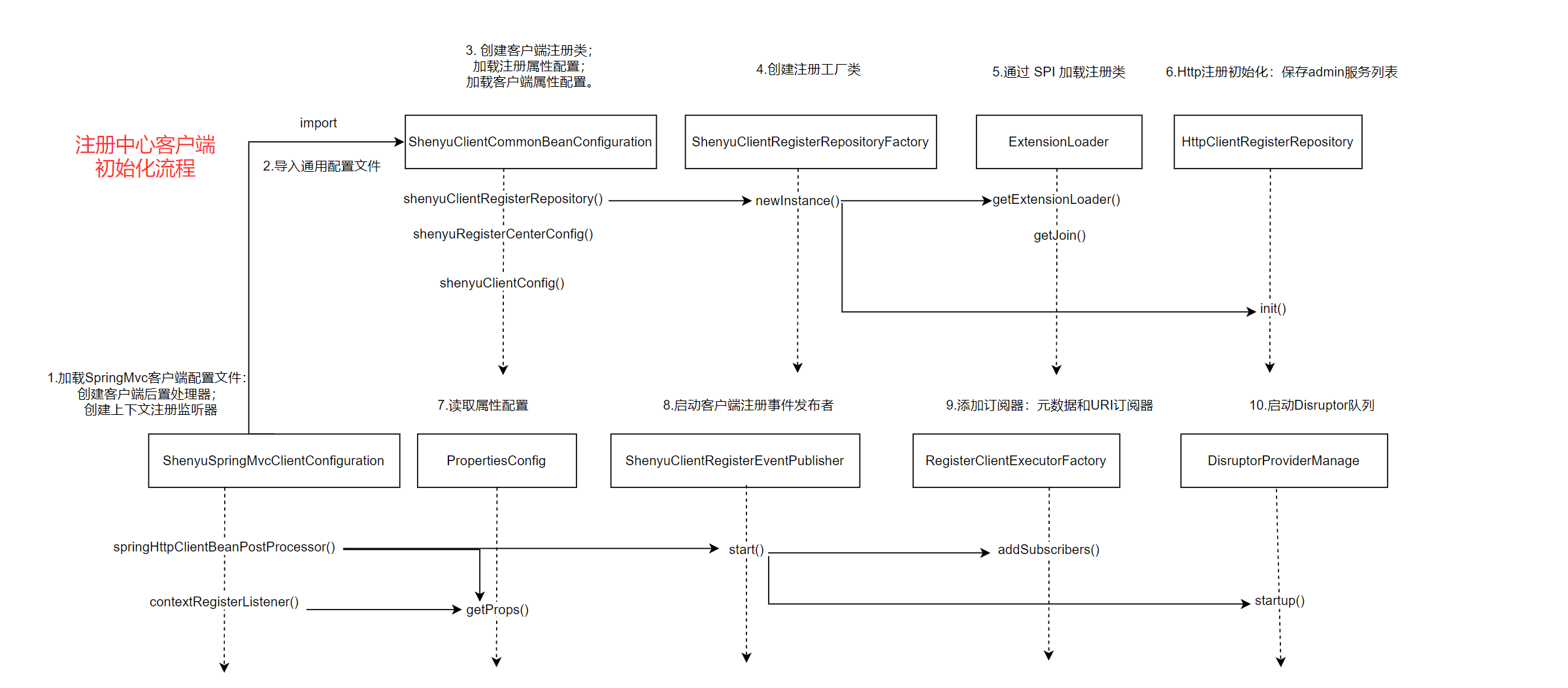

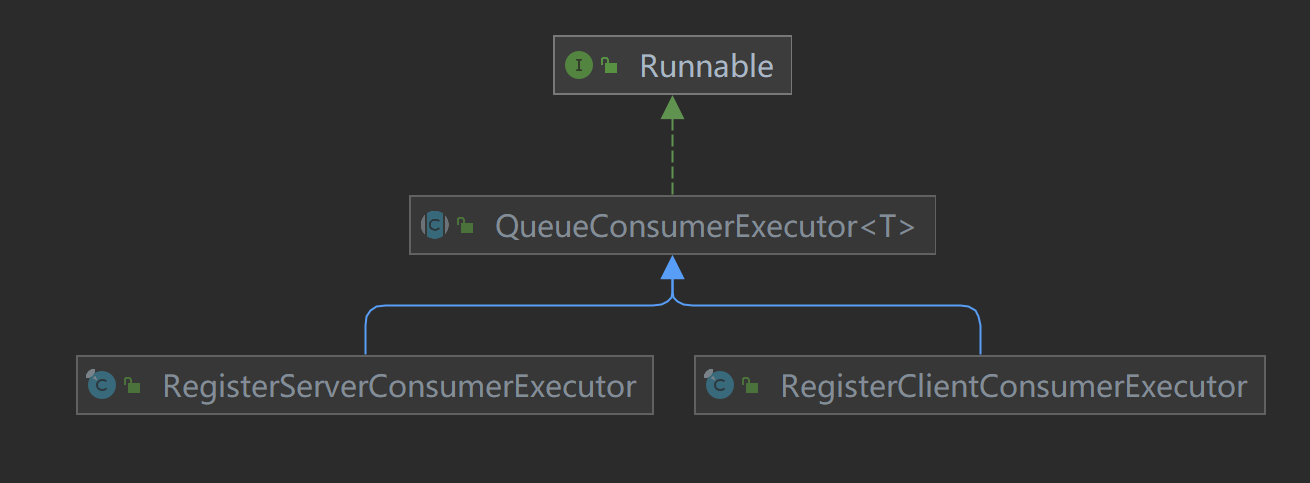


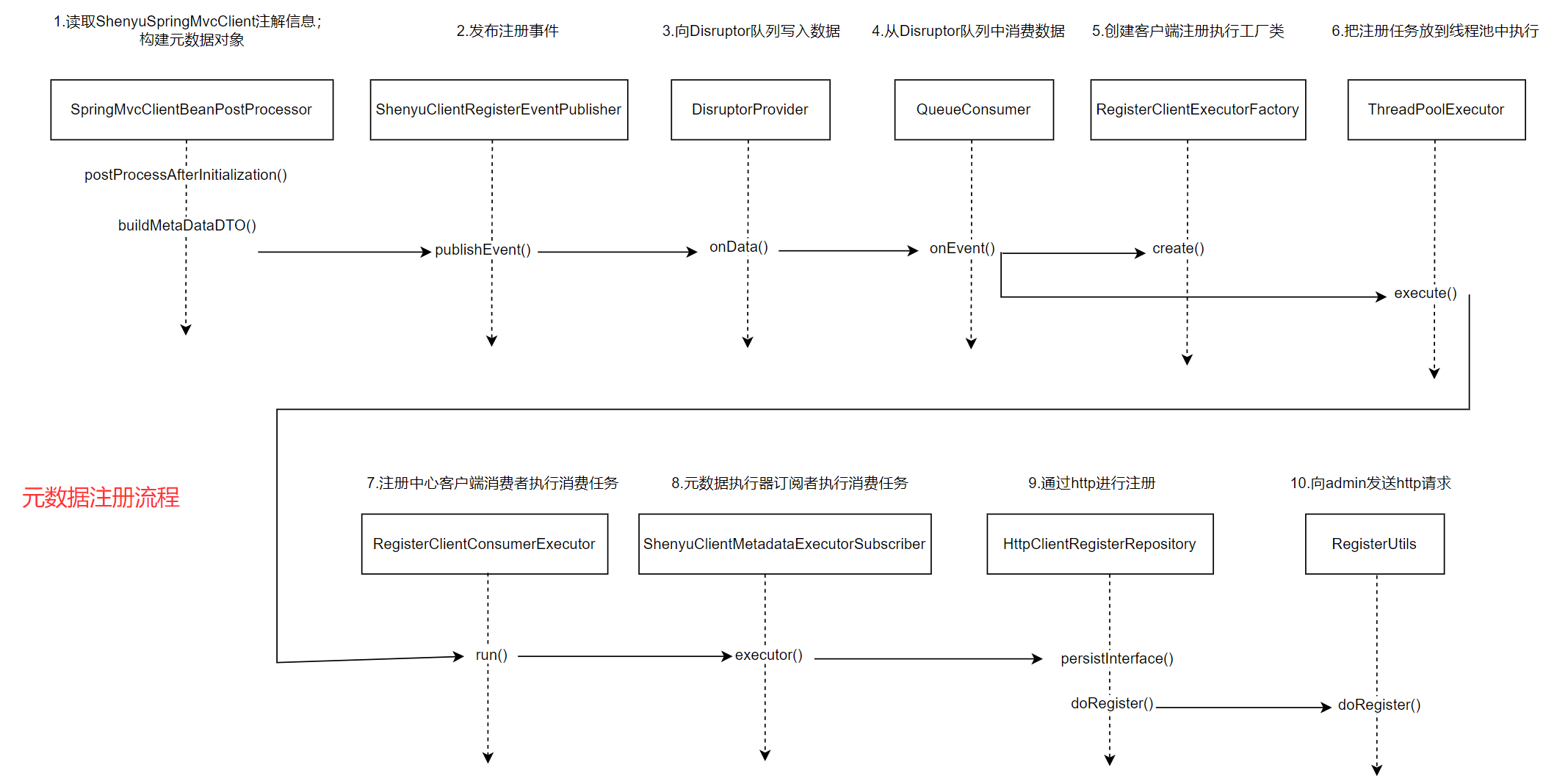

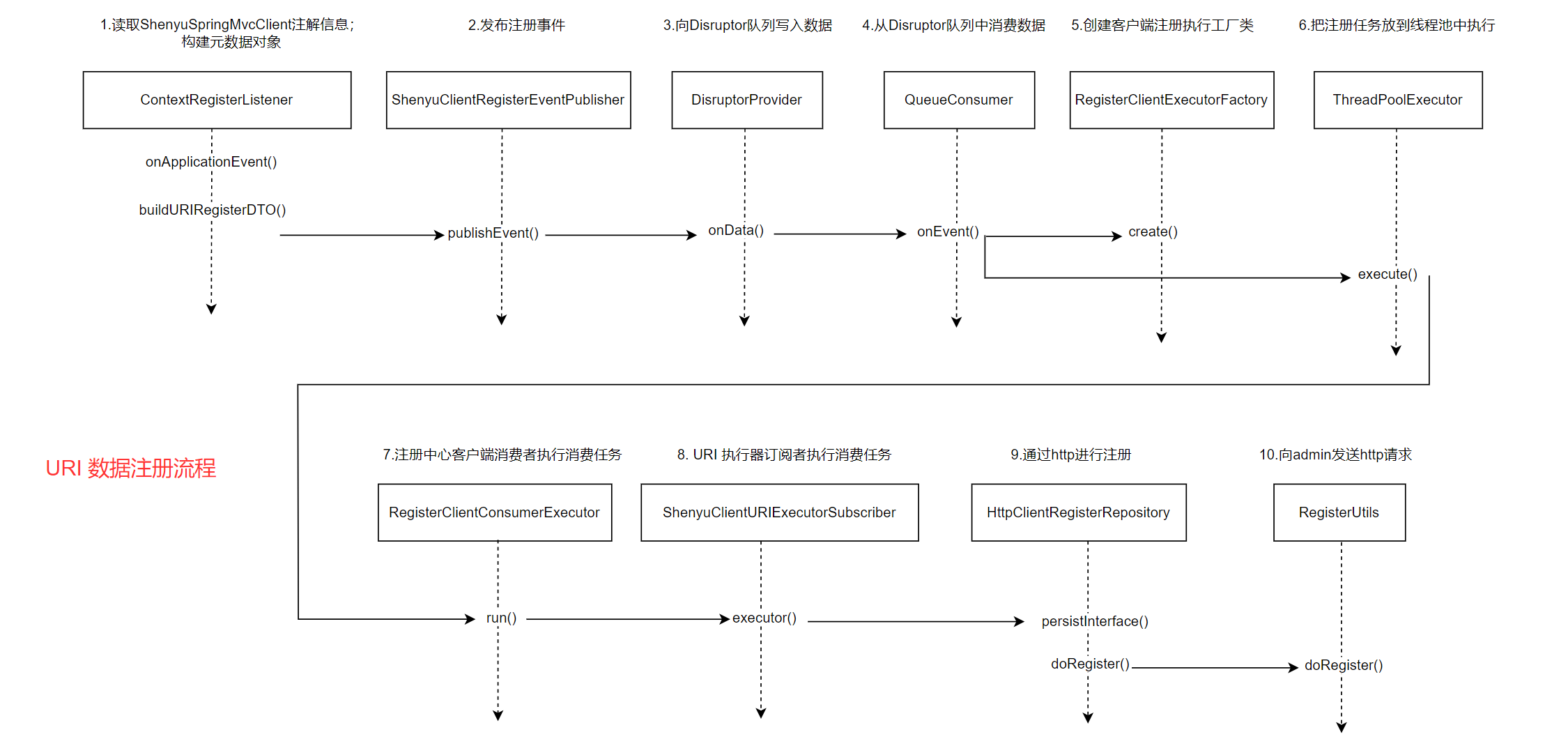



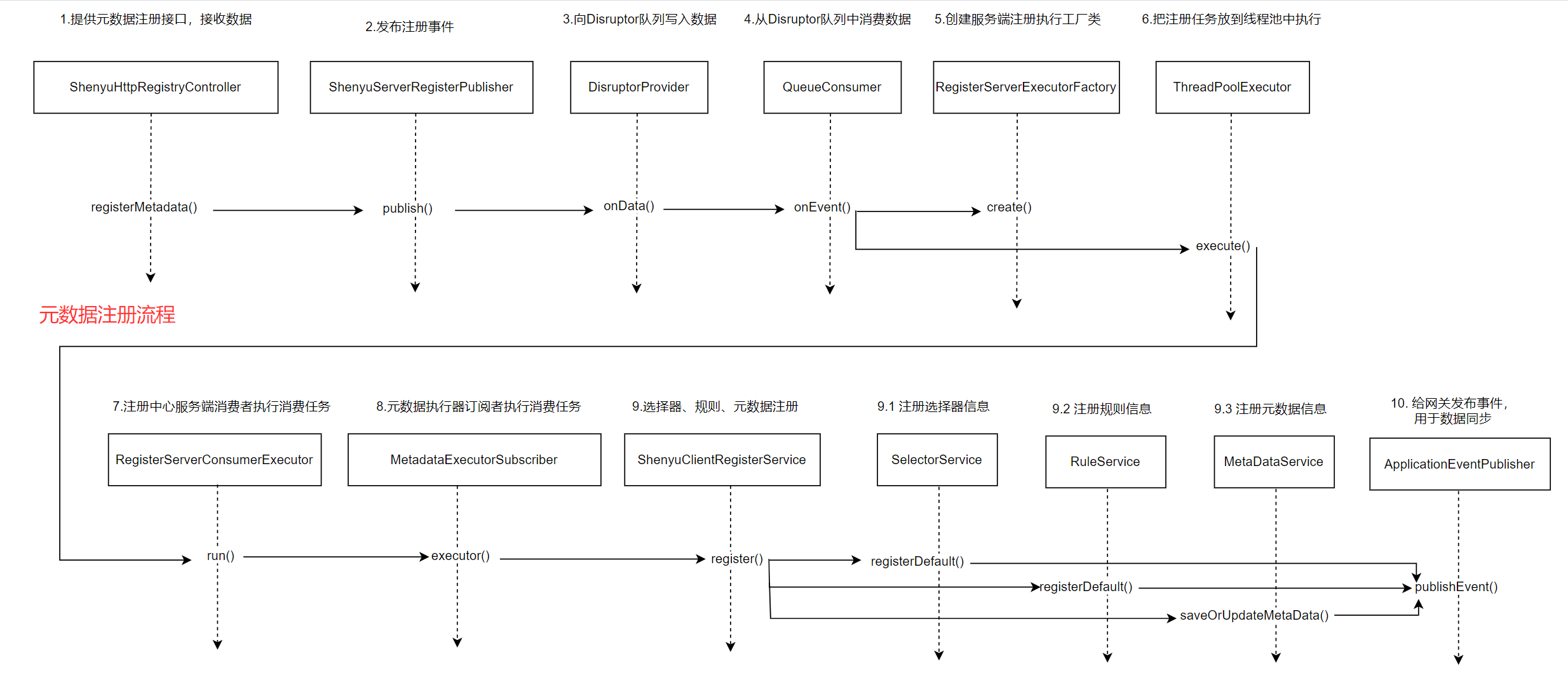
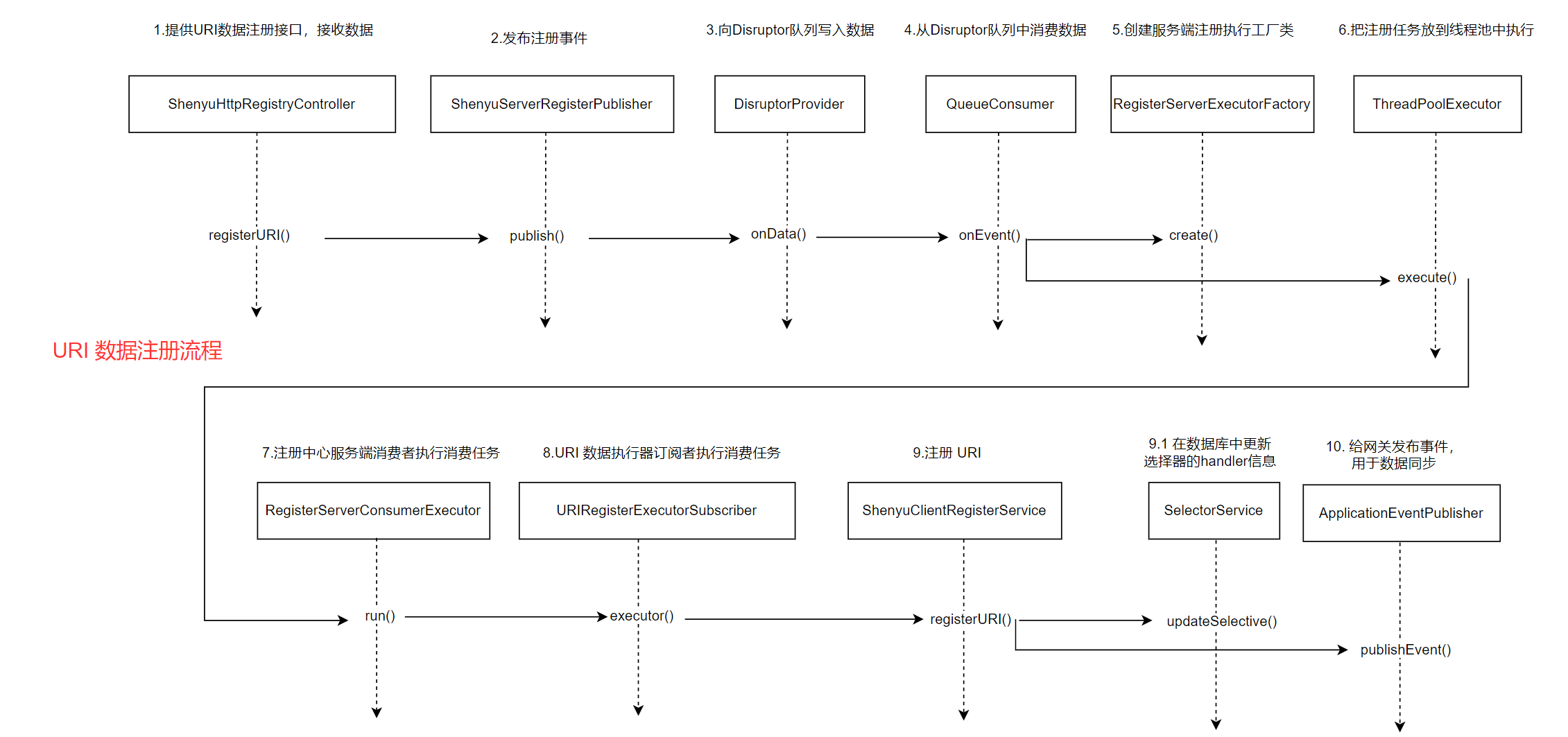












评论